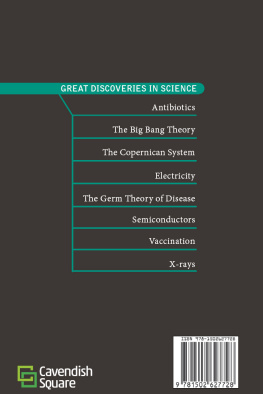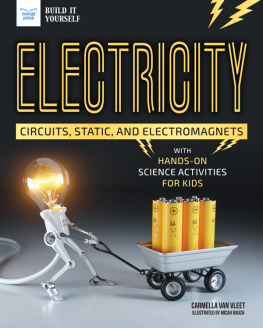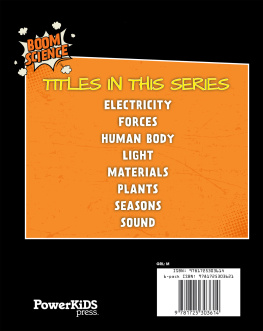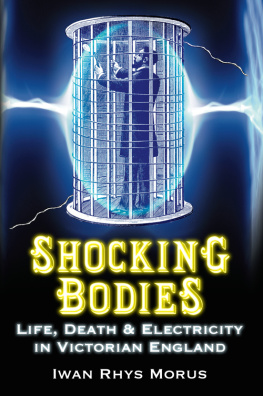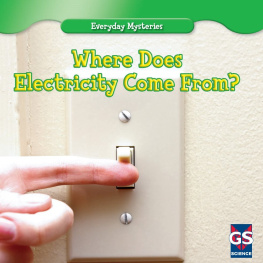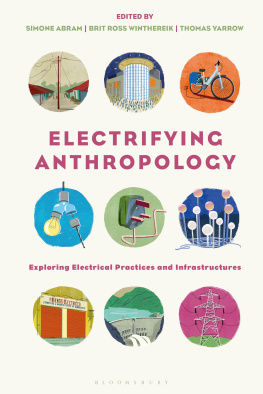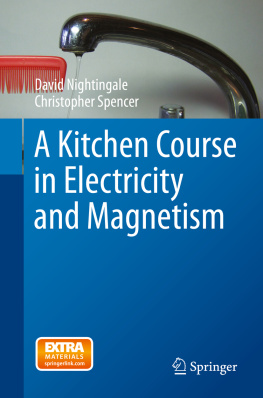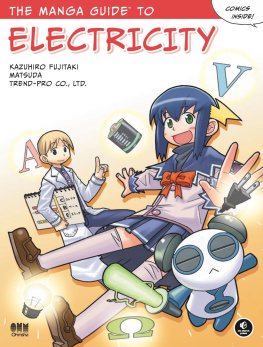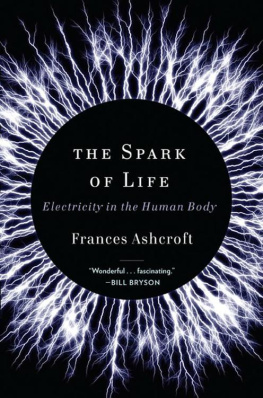GREAT DISCOVERIES IN SCIENCE
Electricity
Patrice Sherman
Published in 2018 by Cavendish Square Publishing, LLC
243 5th Avenue, Suite 136, New York, NY 10016
Copyright 2018 by Cavendish Square Publishing, LLC
First Edition
No part of this publication may be reproduced, stored in a retrieval system, or transmitted in any form or by any meanselectronic, mechanical, photocopying, recording, or otherwisewithout the prior permission of the copyright owner. Request for permission should be addressed to Permissions, Cavendish Square Publishing, 243 5th Avenue, Suite 136, New York, NY 10016.
Tel (877) 980-4450; fax (877) 980-4454.
Website: cavendishsq.com
This publication represents the opinions and views of the author based on his or her personal experience, knowledge, and research. The information in this book serves as a general guide only. The author and publisher have used their best efforts in preparing this book and disclaim liability rising directly or indirectly from the use and application of this book.
CPSIA Compliance Information: Batch #CS17CSQ
All websites were available and accurate when this book was sent to press.
Library of Congress Cataloging-in-Publication Data
Names: Sherman, Patrice.
Title: Electricity / Patrice Sherman.
Description: New York : Cavendish Square Publishing, [2018] | Series: Great discoveries in science | Includes bibliographical references and index.
Identifiers: LCCN 2016053728 (print) | LCCN 2016055332 (ebook) | ISBN 9781502627728 (library bound) | ISBN 9781502627735 (E-book)
Subjects: LCSH: Electricity--Juvenile literature.
Classification: LCC QC527.2 .S534 2018 (print) | LCC QC527.2 (ebook) | DDC 537--dc23
LC record available at https://lccn.loc.gov/2016053728
Editorial Director: David McNamara
Editor: Caitlyn Miller
Copy Editor: Michele Suchomel-Casey
Associate Art Director: Amy Greenan
Designer: Lindsey Auten
Production Coordinator: Karol Szymczuk
Photo Research: J8 Media
The photographs in this book are used by permission and through the courtesy of: Cover Piotr Alfred Pasieka/Science Photo Library/Getty Images.
Printed in the United States of America
Overhead electric lines are so ubiquitous most people hardly notice them until a discerning photographer turns them into art.
ELECTRICITY
Introduction: Powering Our Lives
W e call it juice. It fuels our power grids and fires up our computers. It comes alive with the press of a button or flick of a switch. It gives us heat and light and delivers sounds and sights from distant places to our phones and screens. It flows through the wires that run over our heads and beneath our streets. It even courses through every nerve in our bodies, enabling us to see, laugh, dance, think, run, read, smell, and dream. It can strike with deadly force and yet heal sickness. It is electricityand it is everywhere. The story of the discovery of electricity stretches over twenty centuries, from ancient civilizations to the information age of today. It is a story that touches upon religion, philosophy, mechanics, engineering, physics, chemistry, biology, and mathematics. The people who created that story were scientists, inventors, detectives, dreamers, and occasionally showmen.
Electricity is so omnipresent in our lives that its amazing to realize it was once considered a strange and unknowable force. To ancient people, electricity belonged to the gods. A flash of lightning was Thors hammer or Apollos spear. When the ancient Greeks rubbed a piece of amber against a cats fur, they wondered at the static charge. Perhaps they had wakened a spirit inside, ready to jump out within a tiny spark.
The scientific study of electricity began in the eighteenth century. Benjamin Franklin helped establish the fact that lightning was really made of electricity. Pieter van Musschenbroek of the Netherlands learned how to store it in a jar. In Italy, Luigi Galvani made a frogs leg jump, and in 1800, Alessandro Volta put two and two together to make the worlds first battery from a pile of zinc and copper coins. No one knew exactly what electricity was or how it worked, but the race to see what it could do was on.
Developments and discoveries came from surprising quarters. A London bookbinders apprentice with scarcely any formal education realized he could generate electricity with a set of magnets and a copper coil. This insight made Michael Faraday the father of electromagnetic energy and one of the most famous scientists of all time. Meanwhile, in America, Joseph Henry, an Albany schoolteacher, sparked the idea for the telegraph when he unrolled a wire and made a bell ring.
During the last half of the nineteenth century, a group of remarkable inventors launched the great age of electricity. Telegraph wires sped messages across the continent and then across the world. Thomas Edison received US patent number 223,898 for an electric lamp that burned for a record 1,200 hours and would soon ensure daylight even at night. In 1893, George Westinghouse and Nikola Tesla lit up the Chicago Worlds Fair in a magnificent display of electric power that awed and delighted everyone who saw it.
Through all these events, a small group of research scientists worked quietly behind the scenes on the trail of the elusive electron. Too small to be seen, this infinitesimal bit of matter was the key that explained the great mystery that was electricity. Yet there remains much to be discovered. The same electricity that powers generators also powers our very brains. The same energy that surges through wires controls our own hearts. We, too, are made of electricity. In the twenty-first century, we stand at the edge of a new age of electricityone that may merge minds with computers and open even more doors to the unsolved mysteries of electricity.
Benjamin Franklins kite experiment is one of the most famous electrical experiments, but many historians doubt it actually happened.
CHAPTER 1
The Mystery of Electricity
O ne stormy June night in 1752, Benjamin Franklin went out to fly a kite fashioned from a silk handkerchief with a small metal hook affixed to the top. Franklin had attached a brass key to the kites string within easy reach and brought with him a glass vessel lined with tin called a Leyden jar. He had enlisted the help of his twenty-one-year-old son, who huddled inside a nearby shed holding the end of the kites string to keep it dry while Franklin stood outside and scanned the clouds for any sign of lightning. Though he did not see lightning strike, Franklin noticed some loose threads on the kites string rise and wave about in the air as if pulled upward by a mysterious force. He concluded that the kite must have made contact with some hidden bolt of lightning in the dark clouds, and he touched the brass key with his knuckle. Sure enough, a spark flashed, instantly followed by a powerful jolt zipping through his arm. He held the Leyden jar up to the key and watched as it began to glow, filling up with what he called electric fire. His hypothesis had been correct. Lightning was indeed made of electricity.
Franklins adventure with his kite is one of the most famous scientific experiments in history. It has been depicted in countless paintings and drawings and is included in almost every biography written of him. Yet, some historians doubt that it ever happenedfor a few reasons. First, a kite is not generally a good way to attract lightning. Kites may not fly high enough, and they bob and weave. If Franklins kite was, as he described, no bigger than a large silk handkerchief, it was probably too small and light to support both the weight of the metal cross at its tip and the brass key dragging on its string near the ground. In short, it would never fly. And if it did, by some chance, manage to draw lightning, the resulting shock could have easily killed both Franklin and his son.
Next page
